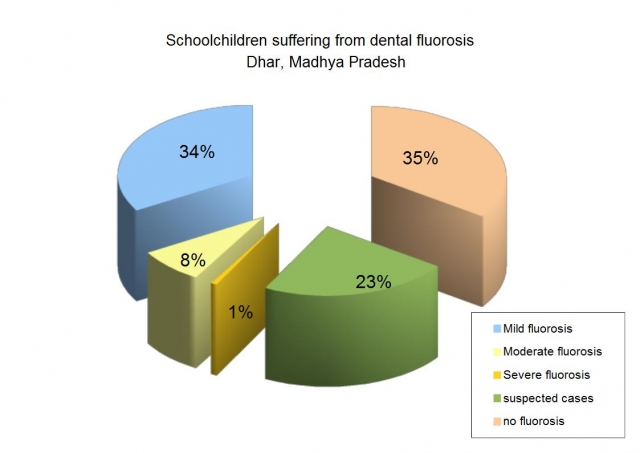Background:
62 million people in India, including 6 million children suffer from fluorosis. The root cause of this is excessive fluoride (>1.5mg/l) in groundwater, as is found in 20 states across India.
Objectives:
- To identify the fluoride affected villages.
- To assess the prevalence of dental fluorosis in the selected schools.
- To undertake water quality testing of all the drinking water sources in selected villages.
- Prepare plans to reduce the prevalence of fluorosis in the selected villages through bringing down concentrations of fluoride in drinking water with full involvement of the communities and government.
- Provide safe drinking water in selected villages.
- Assess of effectiveness of safe water supply by using urinary fluoride data as indicator.
- Identify best operations and maintenance practices for safe water supply schemes for fluoride affected areas.
- Assess effectiveness of small rain water harvesting structures for HP’s and observation of dilution mechanics by big ponds for its downstream command areas
Study area:
Dhar is a district of southern Madhya Pradesh. About 82% of the population belong to the Scheduled Tribes. According to PHED, 1683 sources of drinking water of 3763 tested sources in 324 villages are contaminated.
Geology: The Malwa hills are formed of fractured basaltic rocks, enriched with upper regolith. Basaltic rocks contain fluoride in combined form with either aluminium or with calcium. The Narmada alluvial valley is comprised of sandy silt with variable amount of calcium and aluminium bound with some amount of fluoride.
Methodology:
Health survey: A health survey on dental fluorosis in 1300 children (age 6-16 years) was carried out in 31 schools.
Water quality monitoring of drinking water sources: Data gathered from health survey of school children were summarized village wise. Villages that had severe dental fluorosis in more than 40% children were categorised as target villages. It was decided to carry out Water quality monitoring for all drinking water sources of 8 villages. 109 water sources in the selected 31 habitations of 8 villages were monitored. Battery operated Fluoride ion Meter (Model 290A+ Orion, USA) was used to measure fluoride concentrations. Standard Methods of Water Analysis prescribed by the APHA were followed in analysis of all the parameters.
Preliminary/base line urinary fluoride concentration observation: Individuals were selected randomly for fluoride concentration observation. The individuals were asked to collect their urine samples in the morning when they go for their first urination. The individuals were also explained of the importance of the program and were motivated to cooperate in the study. These samples were analysed for fluoride concentration in the Dhar field laboratory.
Assessment of effectiveness of the safe water supply scheme: Data was collected from 12 villages in the project area.
Identification of seriously affected villages and preparation of mitigation plan:

The water quality assessments carried out in the target areas were used to develop a mitigation programme consisting of either awareness programs, or implementing mitigation measures, or both, in 24 clusters from 8 gram panchayats.
Observations of the study of urinary fluoride concentration:
Of the studies carried out in 9 affected villages, fluoride concentration in urine has been found to be higher than that in water. This is significant in individuals of the age group between 41-55 years of age.
Assessment of the effectiveness of the safe water supply scheme:
The results of the impact assessment study for four programme villages and one control village are presented in this section. The installed water supply schemes are working well ,which has led to a decrease in urinary fluoride values. However, the importance of ceaseless awareness raising is highlighted. There are some cases where people revert to using contaminated handpumps for 'ease of cooking' etc. This can be avoided by providing continual reminders of the danger of such contaminated sources. The efficacy of these measures has encouraged the implementing agencies to carry out fluoride mitigation in 6 additional villages in the area.
The report also has data on urinary fluoride levels in various villages. The fluoride levels of the water sources tested are attached, along with the geographical coordinates of these sources.
/articles/fluorosis-mitigation-dhar-madhya-pradesh-experiences-monitoring-fluoride-levels-drinking